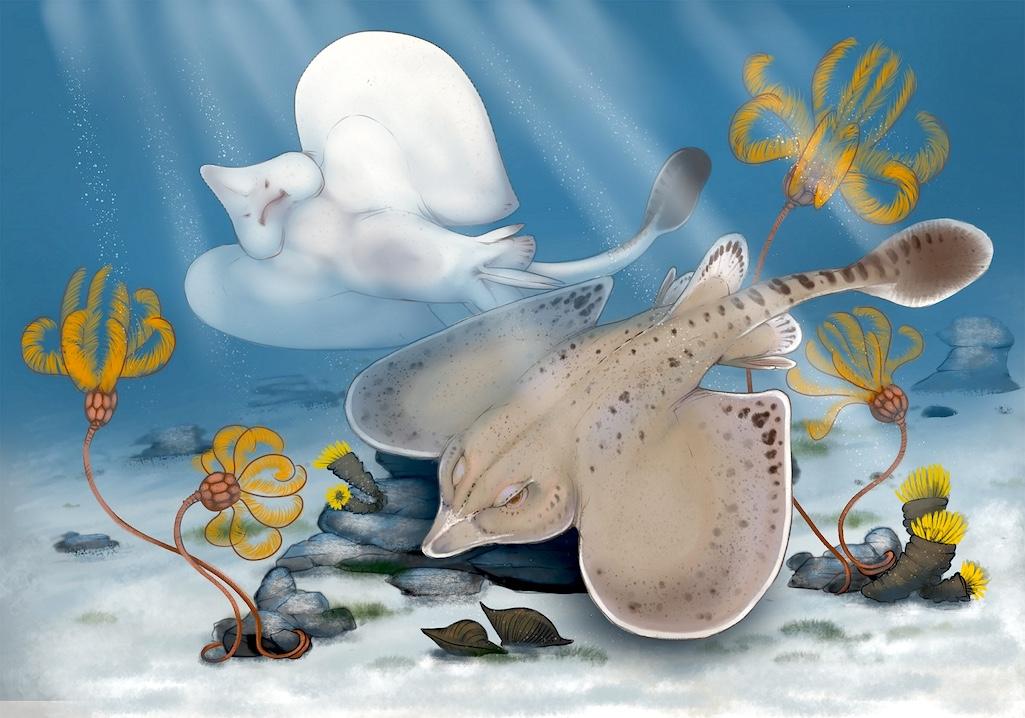
An illustration of Strigilodus tollesonae created specially by artist Benji Paysnoe. The new species is more closely related to modern ratfish than to other modern sharks and rays/Illustration by artist Benji Paysnoe
Spoon-sized fossils found within Mammoth Cave National Park in Kentucky belonged to a previously unknown shark species that swam hundreds of millions of years ago.
The fossils found in a cave wall and ceiling were of the teeth from Strigilodus tollensonae, a type of extinct shark that is more closely related to modern ratfish than to other modern sharks and rays. The teeth uncovered at Mammoth Cave represent all known tooth positions in the mouth of both adult and juveniles of the new species, a park release said.
The teeth were arranged in a fan-like structure with a large tooth in the middle and three other teeth, decreasing in size, next to it. Each tooth had a single rounded curved cusp for clipping and grasping hard shell prey, while the inner/tongue side of the tooth was long with ridges for crushing. Strigilodus tollesonae may have lived like a modern skate, feeding on snails, bivalves, soft bodied worms, and smaller fish.
“We are excited to finally announce the discovery of our first new shark species at Mammoth Cave,” said Mammoth Cave Superintendent Barclay Trimble, who announced the find Wednesday, National Fossil Day. “Teams of geologists, paleontologist, park staff, and volunteers have been hard at work deep inside the cave identifying and collecting fossils since the paleontological resources inventory began in 2019. Their important research allows us to better understand the scope, significance, distribution, and management issues associated with the fossil record found within Mammoth Cave.”
The name Strigilodus tollesonae translates to “Tolleson’s Scraper Tooth.” It is named in honor of Mammoth Cave National Park Guide Kelli Tolleson, who provided outstanding field support for the paleontological resources inventory. Tolleson discovered many important fossil localities through her work and led expeditions to the fossil sites, which are limited in accessibility due to the remote and sometimes challenging sections of cave where the specimens are found. Many of the sites are in areas of low ceilings that require crawling for long distances on hands and knees, and at times, belly crawling. The fossils are commonly located in the cave ceilings or walls which researchers and volunteers carefully collect using small handheld tools.
The 325 million-year-old fossil-rich limestones of the Mammoth Cave system were formed during the Late Paleozoic, a time period known to geologists as the Mississippian Period.
The inventory began in November 2019 when shark fossil specialist John-Paul Hodnett of the Maryland-National Capital Parks and Planning Commission began to work with the NPS Paleontology Program to identify the park’s shark fossils. At least 70 species of ancient fish have been identified at Mammoth Cave from the more than 25 caves and cave passages that have been surveyed.
National Fossil Day is officially celebrated on October 11, 2023, but Mammoth Cave National Park will celebrate the Strigilodus tollesonae discovery and other types of fossils found within the cave system on Monday, October 23. Paleontologists, educators, and park guides will present fossil-related activities to highlight the scientific and educational value of paleontology and the importance of preserving fossils for future generations. More information about the Mammoth Cave event will be released closer to the event date.


